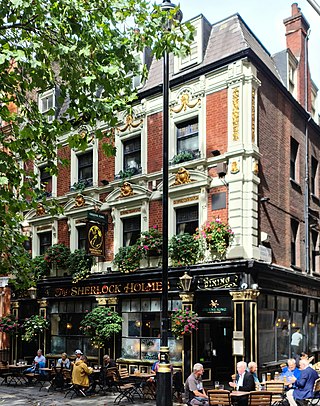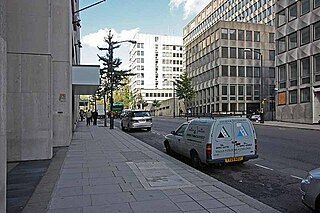
Northumberland Street is a street in the City of Westminster.

Northumberland Street is a street in the City of Westminster.
The street runs from Strand in the north to Northumberland Avenue in the south. On its east side it is joined by Corner House Street and Craven Passage. It is part pedestrianised in the section leading off the Strand.
Northumberland Street was originally known as Hartshorn Lane. The buildings in that lane were demolished to make way for Northumberland Street in the 1760s. [1]
Dramatist Ben Jonson (c. 1572–1637) spent his youth in Hartshorn Lane and may have been born there. [2]
On 12 July 1861, workmen saw a terribly wounded man, Major Murray, emerging from 16 Northumberland Street, crying "murder". They went upstairs and found a solicitor's office covered in blood. Another severely wounded man, Mr. Roberts, was crouched on the floor surrounded by evidence of a terrible fight: pools of blood, broken wine bottles, pistols, and overturned furniture. Roberts died of his wounds; Murray survived. His version of events was that he had been lured into the rooms under false pretences, and that Roberts had tried to kill him, and they had fought. He claimed to have no idea why he was attacked. However, police established that Roberts had become obsessed with Murray's mistress, and had planned to kill him out of jealousy. At Murray’s trial, the jury deemed his crime "justifiable homicide" because it was self-defence. [3] [4]
The Sherlock Holmes public house is located in the south of the street on the corner with Craven Passage.
The Royal Institution of Naval Architects is located at Nos. 8–9. [5]
The offices of the Association of Teachers and Lecturers are at No. 7. [6]

Drury Lane is a street on the eastern boundary of the Covent Garden area of London, running between Aldwych and High Holborn. The northern part is in the borough of Camden and the southern part in the City of Westminster. Drury Lane is part of London's West End Theatreland.

The Marble Arch is a 19th-century white marble-faced triumphal arch in London, England. The structure was designed by John Nash in 1827 as the state entrance to the cour d'honneur of Buckingham Palace; it stood near the site of what is today the three-bayed, central projection of the palace containing the well-known balcony. In 1851, on the initiative of architect and urban planner Decimus Burton, a one-time pupil of John Nash, the arch was relocated to its current site, near the northeast corner of Hyde Park, so that expansion of Buckingham Palace could proceed.

Hyde Park Corner is between Knightsbridge, Belgravia and Mayfair in London, England. It primarily refers to a major road junction at the southeastern corner of Hyde Park, that was originally planned by architect Decimus Burton. The junction includes a broad green-space roundabout in its centre, which is now the setting for Burton's triumphal Wellington Arch.

James Paine (1717–1789) was an English architect. He worked on number of country houses such as Chatsworth House, Thorndon Hall and Kedleston Hall.

Northumberland House was a large Jacobean townhouse in London, so-called because it was, for most of its history, the London residence of the Percy family, who were the Earls and later Dukes of Northumberland and one of England's richest and most prominent aristocratic dynasties for many centuries. It stood at the far western end of the Strand from around 1605 until it was demolished in 1874. In its later years it overlooked Trafalgar Square.

Northumberland Avenue is a street in the City of Westminster, Central London, running from Trafalgar Square in the west to the Thames Embankment in the east. The road was built on the site of Northumberland House, the London home of the Percy family, the Dukes of Northumberland between 1874 and 1876, and on part of the parallel Northumberland Street.

East India House was the London headquarters of the East India Company, from which much of British India was governed until the British government took control of the company's possessions in India in 1858. It was located in Leadenhall Street in the City of London. The first East India House on the site was an Elizabethan mansion, previously known as Craven House, which the Company first occupied in 1648. This was completely rebuilt in 1726–29; and further remodelled and extended in 1796–1800. It was demolished in 1861. The Lloyd's building, headquarters for Lloyd's of London, was built on the site of the former East India House.

York House was one of a series of grand mansions that formerly stood on the Strand, the principal route from the City of London to the Palace of Westminster.
A sponging-house was a place of temporary confinement for debtors in the United Kingdom.

Arundel House was a London town-house located between the Strand and the River Thames, near the Church of St Clement Danes.
Cecil House refers to two historical mansions on The Strand, London, in the vicinity of the Savoy. The first was a 16th-century house on the north side, where the Strand Palace Hotel now stands. The second was built in the early 17th century on the south side nearly opposite, where Shell Mex House stands today.

Adelphi is a district of the City of Westminster in London. The small district includes the streets of Adelphi Terrace, Robert Street and John Adam Street. Of rare use colloquially, Adelphi is grouped with Aldwych as the greater Strand district which for many decades formed a parliamentary constituency and civil registration district.

Wych Street was in London where King, Melbourne and Australia Houses now stand on Aldwych. It ran west from the church of St Clement Danes on the Strand to meet the southern end of Drury Lane. It was demolished by the London County Council in around 1901, as part of redevelopment bisected by new street Aldwych, the east of which mimics its course, in a curved way so taking up land buildings stood on, and these works created Kingsway.

James Hackman, briefly Rector of Wiveton in Norfolk, was the man who murdered Martha Ray, singer and mistress of John Montagu, 4th Earl of Sandwich.

The Sherlock Holmes is a Victorian-themed public house in Northumberland Street near Charing Cross railway station and Trafalgar Square which contains a large collection of memorabilia related to the fictional detective Sherlock Holmes. The original collection was put together for display in Baker Street in London during the Festival of Britain in 1951.

The Strand Campus is the founding campus of King's College London and is located on the Strand in the City of Westminster, adjacent to Somerset House and continuing its frontage along the River Thames. The original campus comprises the Grade I listed King's Building of 1831 designed by Sir Robert Smirke, and the college chapel, redesigned in 1864 by Sir George Gilbert Scott with the subsequent purchase of much of adjacent Surrey Street since the Second World War and the 1972 Strand Building. The Macadam Building of 1975 previously housed the Strand Campus Students' Union and is named after King's alumnus Sir Ivison Macadam, first President of the National Union of Students.

Craven Street is a street in the City of Westminster, London, England, near The Strand. Several notable historical figures have lived in the street which was the home of Benjamin Franklin, when he lived in London before the American Revolution.

Francis Edmund Hayman Fowler was a British architect who designed the Metropole Hotel with James Ebenezer Saunders. He was a member of the Metropolitan Board of Works but was forced to resign after being found guilty of corruption.

Milford Lane is a narrow street in the City of Westminster that runs from Strand in the north to a brief walkway section leading to Temple Place in the south. It is joined by Little Essex Street and Essex Street on its eastern side. Maltravers Street once joined the lane to Arundel Street, but ceased to exist when building work at 190 Strand was completed.

Arundel Street is a street in the City of Westminster, London, that runs from Strand in the north to Temple Place in the south. It is on land once occupied by Arundel House and its gardens.
![]() Media related to Northumberland Street, London at Wikimedia Commons 51°30′26.82″N0°7′32.39″W / 51.5074500°N 0.1256639°W
Media related to Northumberland Street, London at Wikimedia Commons 51°30′26.82″N0°7′32.39″W / 51.5074500°N 0.1256639°W